Lake Guardian: Lights, Camera ... Clayton!
FRIDAY, JULY 12, 2013
Even in this Quaint Village on the St. Lawrence River, the Educators Learn it's Not Easy to go Unnoticed by the Locals, Tourists, and the Media; Laboratory Work Takes Center Stage as the Teachers Reveal to Reporters What's in the Water Samples They've Been Drawing from Lake Ontario
After sampling Lake Ontario's water and bottom muds for several days straight (which was detailed in the July 10, 2013 blog post, "
Let the Sampling Begin!"), the educators aboard the
U.S. Environmental Protection Agency's
R/V Lake Guardian were rather pleased to rest their 'lake legs' for awhile. But, while they docked in Jefferson County's quaint
Village of Clayton, it wasn't too long before the 180-foot research vessel they came in on got noticed.
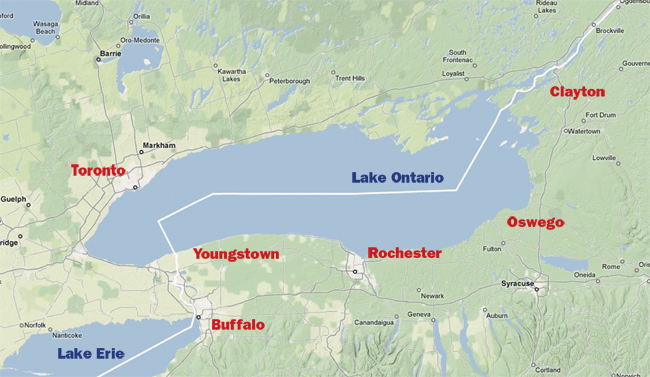
Located in one of the furthest northeastern sections this group will travel to in the Lake Ontario basin, Clayton is situated on the southern bank of the
St. Lawrence River, which originates at the outflow of Lake Ontario between Kingston, Ontario, Canada on the north bank, Wolfe Island in mid-stream, and Cape Vincent, New York on the south bank.
It's an area set in what's known as the
Thousand Islands region, an archipelago of 1,864 islands that straddle the Canada-U.S. border in the River as it emerges from this northeast corner of Lake Ontario. The islands stretch for about 50 miles downstream from Kingston, Ontario. The teachers will visit one of the islands on this, the U.S. side of the region, while here in Clayton. A report from Governor's Island — home to the
State University of New York College of Science and Environmental Forestry's
Thousand Islands Biological Station — will follow in a later blog post.
Back in Clayton, villagers and tourists alike made their way around the dock to get a glimpse of the blue and green striped boat. And, by the end of the day, its visit made front-page, "above the fold" news on the Web site for
Your New Now (YNN) (
pictured below, [1]), a television station available to nearly 600,000 cable subscribers across a 25-county, 15,000 square mile area in Central/Northern New York as well as the State's Southern Tier.
So, the
R/V Guardian wasn't in stealth mode. And, with all that it and its passengers have to offer, why should it be?

In addition to generating interest with YNN reporter
Carmella Mataloni (
pictured below, [3-4], who interviewed, respectively,
New York Sea Grant's Coastal Education Specialist
Helen Domske [2] and
State University of New York College of Environmental Science and Forestry's
Dr. Greg Boyer [4], this stop on the "Shipboard and Shoreline Science Workshop" brought aboard reporters from several newspapers (
Watertown Daily Times (
pdf), a daily, and
Thousand Islands Sun, a weekly) as well
WRVO / North Country Public Radio. Based in Oswego, NY, WRVO Public Media is a station of the National Public Radio digital network with quite a reach — broadcasting news on 89.9 FM and HD-2 Oswego/Syracuse; 90.3 FM and HD-2 Syracuse; 91.7 FM and 99.9 Watertown; 90.1 FM Hamilton; 91.9 FM Utica; 90.5 FM Cortland; 90.7 FM Geneva; and 89.9 Norwich.
A considerable amount of media coverage was also do in part by an
Associated Press article that ran a day prior to docking in Clayton. The article was quickly picked up by dozens of local papers and online sources, including the
Buffalo News, New York's
NBC 4,
Newsday and
News 12 Brooklyn.
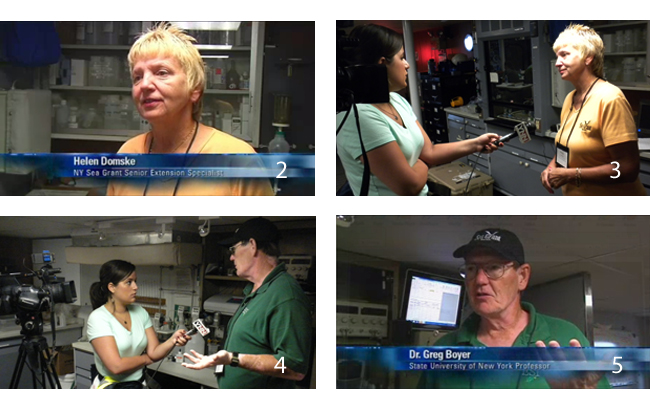
In addition to interviewing Domske and Boyer, YNN's Mataloni spoke with several of the teachers (
pictured below, [6-9]) in the laboratories aboard the
R/V Lake Guardian, where they examined the water and Lake bottom mud samples that they've been collecting at now some two dozen stations along the way.
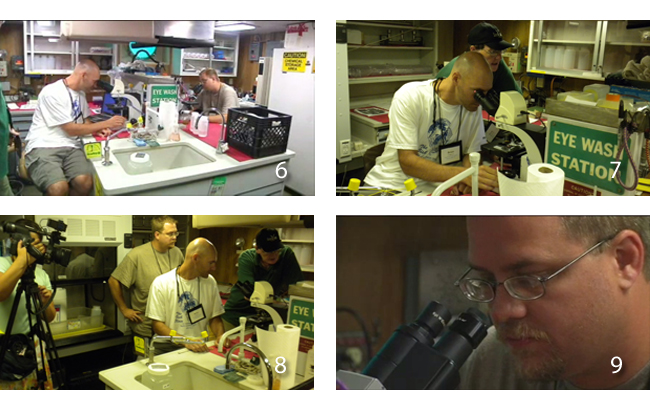
Later in the day, Mataloni also accompanied the educators to the
Thousand Islands Biological Station to help round out her report.
Here's the video clip ...
And here's a transcript of what the reporter took away from her time with the educators and researchers on Clayton's shoreline and on-board the
R/V Lake Guardian ...
Starting in Youngstown and working their way up, 15 teachers from five different states have been on the EPA Lake Guardian research vessel since last Saturday.
While on 24 hour watch rotations, the group has stopped at over a dozen research sites, taking water samples from the Great Lakes.
"It's important to get the teachers out and involved so they can take it back to their classrooms. So we spend time talking about what the problems are in the Great Lakes," said Dr. Greg Boyer, a professor with the SUNY system.
After they collect water samples, they use on board labs to study their samples and analyze chemistry and water quality.
In Clayton Wednesday, teachers got a closer look at what types of fish, insects and algae can be found along in the lake. All the information collected will soon be used in the U.S. EPA and Environment Canada study on the health of Lake Ontario.
"They are actually getting to collect real data that is then used by the EPA as part of the greater information base," said Helen Domske, New York Sea Grant Senior Extension Specialist.
"I am really gaining new perspectives on our Great Lakes watershed and the role that all of us, whether we are scientists or not, play in maintaining that resource," said Italo Baldassarre, an elementary teacher in Niagara Falls, New York.
Educators say participating in this type of hands on project gives them a better understanding of aquatic research. That way when they get back to their classroom, teaching it to their students will be much easier.
"The education you get behind traveling is engrained. You learn so much more when it is hands on than if you read out of a book," said Tonia Henry, a middle school teacher from Minnesota.
Before heading back to Youngstown, the vessel will dock at one more research stop in Oswego.

And what were some of the specimens the teachers examined, not only during YNN reporter Mataloni's stay, but also at other points during the week so far?
Here (
pictured below, [11-15]) are a few of the specimen caught under the microscope from sample collected during the week at various stations across Lake Ontario. Thanks to
Elizabeth Overmier, an educator from Ohio, and to Dr. Boyer for snapping the shots. Helping identify the micro-organisms were Boyer as well as
Kristin TePas,
Illinois-Indiana Sea Grant's Community Outreach Specialist and liaison to the
U.S. Environmental Protection Agency's (U.S. EPA)
Great Lakes National Program Office, and
Jackie Adams, Environmental Scientist at U.S. EPA.

Zooplankton - Copepod (Magnification: 200x)
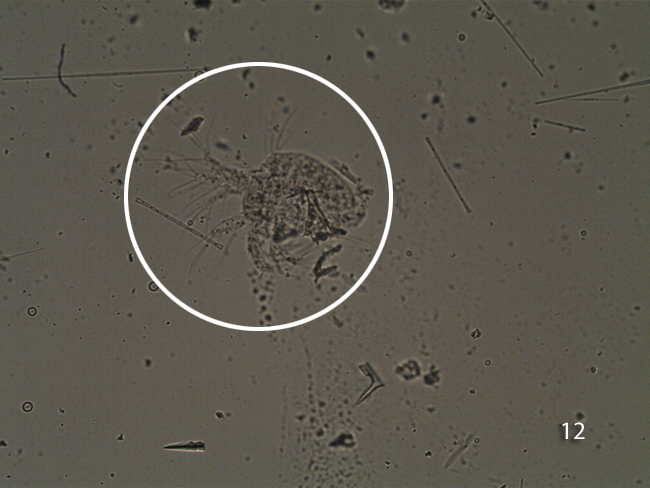
Zooplankton - Copepod (Magnification: 200x)
(
Pictured above, [11-12]): As cited in an earlier blog post,
zooplankton are a primary food source
for Great Lakes sportfish such as walleye and yellow perch. At stations
where water samples are drawn at shallower depths (10 - 20 meters deep)
are where
phytoplankton will be abundant, while zooplankton would be
expected more in samples taken at deeper depths (down at 80 meters or
more below the Lake's surface).
Copepods are a group of small
crustaceans found in the sea and nearly every freshwater habitat. Some
species are planktonic (drifting in sea waters), some are benthic
(living on the ocean floor), and some continental species may live in
limno-terrestrial habitats and other wet terrestrial places, such as
swamps, under leaf fall in wet forests, bogs, springs, ephemeral ponds
and puddles, damp moss, or water-filled recesses of plants.
Planktonic
copepods are important to global ecology and the carbon cycle. They are
usually the dominant members of the zooplankton, and are major food
organisms for small fish, whales, seabirds and other crustaceans such as
krill in the ocean and in fresh water.
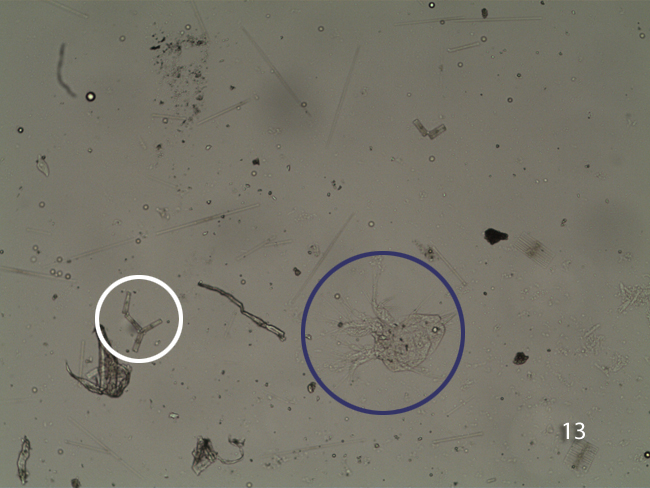
Phytoplankton - Diatoms (Magnification: 100x)
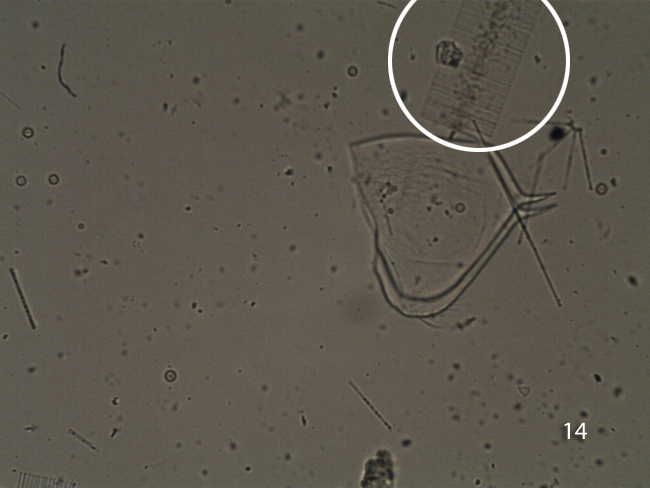
Phytoplankton - Diatoms (Magnification: 200x)
(
Pictured above, [13-14]): Various
diatoms, a major group of algae (single-celled golden-brown) and among the most common types of phytoplankton.
Phytoplankton are photosynthesizing microscopic organisms inhabit the
upper sunlit layer of almost all oceans and bodies of fresh water, like
Lake Ontario. They are agents for "primary production," the creation of
organic compounds from carbon dioxide dissolved in the water, a process
that sustains the aquatic food web.
Diatoms are photosynthetic
and produce large amounts of oxygen (due to the considerable numbers of
them in the lakes and oceans. There are over 100,000 different species
of diatoms worldwide. Included in
[13] are
Tabellaria (
bottom left - white circle)
, a genus of diatoms with are characterized by the "chain" they form.
Also spotted ...
[13]:
Nauplius, the larvae of copepods (
middle bottom - blue circle). The nauplius stage (plural:
nauplii)
is characterized by the use of the appendages of the head (the
antennae) for swimming. The nauplius is also the stage at which a
simple, unpaired eye first appears. The eye is known for that reason as
the "naupliar eye," and is often absent in later developmental stages,
although it is retained into the adult form in some groups.
[14]:
Fragilaria (
upper right), a diatom that is often abundant in the plankton of lakes.
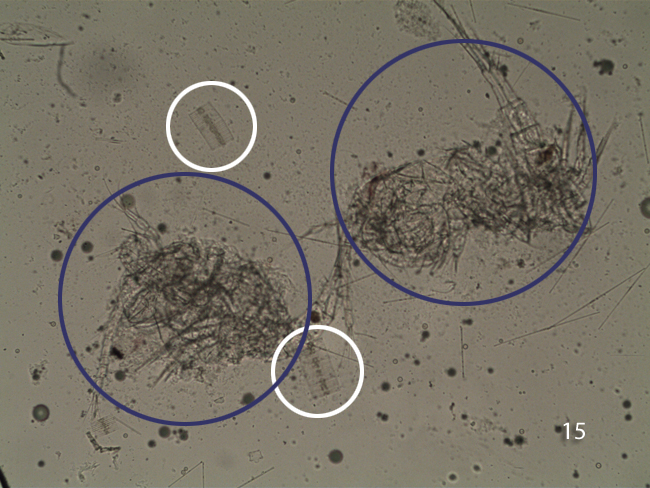
(Magnification: 100x)
(
Pictured above, [15]): Phytoplankton - Diatoms (
upper left and lower middle - white circles)
Zooplankton - likely
Cyclopoids (
largest organisms, seen in middle - blue circles). Like many other copepods, members of
Cyclopoida are small, planktonic animals living both in the sea and in freshwater habitats. They are capable of rapid movement.

Bacteria - Cyanobacteria -
Anabaena (Magnification: 200x)
Anabaena is a filamentous
cyanobacteria that exists as plankton. It is known for its nitrogen fixing abilities, and they form symbiotic relationships with certain plants. They are one of four genera (plural for genus) of cyanobacteria that produce neurotoxins, which are harmful to local wildlife, as well as farm animals and pets. Production of these neurotoxins is assumed to be an input into its symbiotic relationships, protecting the plant from grazing pressure.
For more on cyanobacteria, see the July 9, 2013 blog post, "
Safety First: But, Are They Harmful?"

Phytoplankton - Diatom -
Fragilaria (Magnification: 200x)
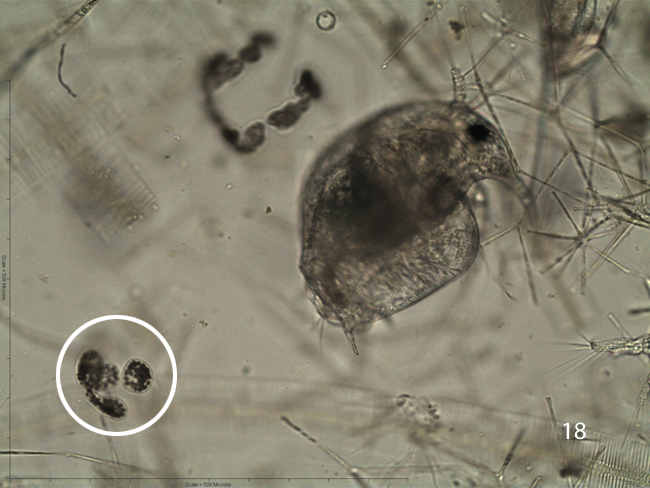
Arthropod- Crustacean -
Bosmina (Magnification: 200x)
Bosmina are filter feeders consuming algae and protozoans. They are known to have a dual feeding mechanism and can filter the water using their second and third legs and the first leg will grab the particles.
Also spotted ...
Microcystis (
lower left - white circles)
For more on
Microcystis and other algae, see the July 9, 2013 blog post, "
Safety First: But, Are They Harmful?"

Cluster of algae (Magnification: 100x)
For more on algae, see the July 9, 2013 blog post, "
Safety First: But, Are They Harmful?"